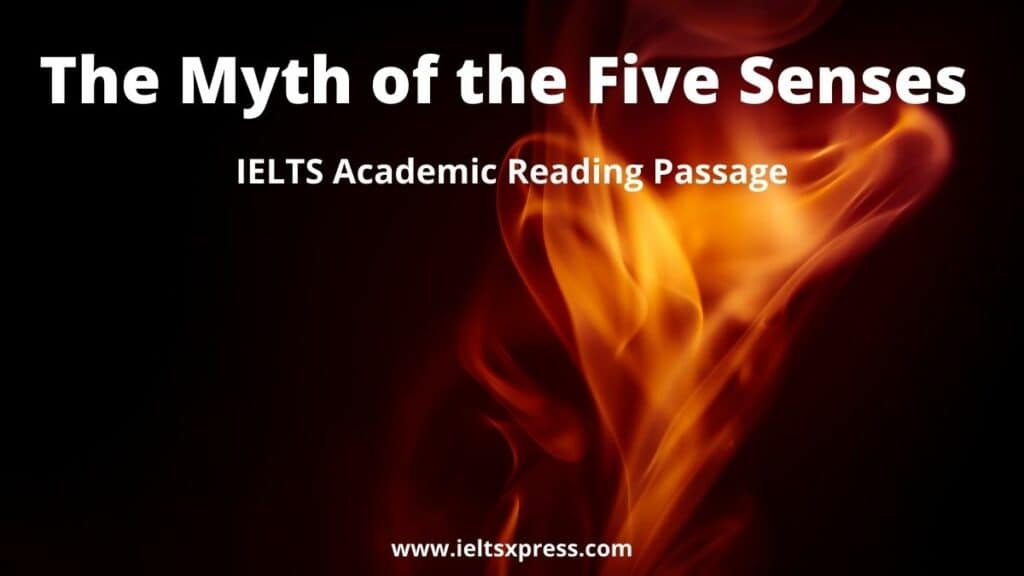The Myth of the Five Senses IELTS Reading Passage with Answers
Reading Passage 3
You should spend about 20 minutes on Questions 28-40 which are based on Reading Passage 3 below.
The Myth of the Five Senses
A
We see with our eyes and taste with our tongues. Ears are for hearing, skin is for feeling and noses are for smelling. Would anyone claim that ears can smell, or that tongues can see? As a matter of fact, yes. Paul Bach-y-Rita, a neuroscientist at the University of Wisconsin at Madison, believes that the senses are interchangeable; for instance, a tongue can be used for seeing. This “revolutionary” study actually stems from a relatively popular concept among scientists; that the brain is an accommodating organ. It will attempt to carry out the same function, even when part of it is damaged, by redirecting the function to another area of the brain. As opposed to previous mainstream scientists’ understanding that the brain is compartmentalized, it is now more acceptable that the individual “part” of the brain could be somewhat interchangeable.
B
Paul Bach-y-Rita’s experiments suggest that “we experience the five senses, but where the data comes from may not be so important”. In the article “Can You See With Your Tongue?” the journalist was blindfolded with a small video camera strapped to his forehead, connected to a long plastic strip which was inserted into his mouth. A laptop computer would convert the video’s image into a fewer number of pixels, and those pixels would travel through the plastic strip as electric current, reaching the grid of electrodes that was placed inside the man’s mouth. The scientist told the man that she would soon be rolling a ball towards his right side, left side, or center, and he would have to catch it. And as the journalist stated, “my eyes and ears have no way to tell where it’s going. That leaves my tongue… has more tactile nerve endings than any part of the body other than the lips”. The scientist rolled the ball and a “tingling” passed over the man’s tongue, and he reached out with his left hand and caught the ball.
C
If the b+rain can see a ball through a camera and a wet tongue, many new questions arise. What does this concept imply in terms of blindness and deafness? Rather than attempting to reserve these sensory disabilities through surgeries and hearing aids, should we be trying to circumvent them by using different receptors?4 Can we still trust in the idea of the five senses, or was it wrong to categorize our perception of the outside world so strictly?
D
In fact, the “five senses” may well be another story that should be discarded in lieu of new observation. Aside from the emerging possibility of interchanging a tongue and an eye, there is the highly accepted possibility that our original list of senses is incomplete. Many scientists would add at least these two senses to the list: the kinesthetic sense and the vestibular sense. The first is a sense of self, mostly in terms of limbs and their placement. For instance, I know where my right foot is without looking or feeling for it. It is something that my brain “knows”. This is said to be because of information sent to the brain by the muscles, implying that muscles should be added to the list of sensory organs. If more observations were to be collected on this subject, a more accommodating explanation could potentially be reached. Secondly, the vestibular sense is what most would consider a sense of balance.
E
Why were these two senses not included in our limited list? It might be the result of a lack of external symbolism. A nose or an eye is an obvious curiosity because of the question it generates: “What does this thing do?” But we have no limb or facial organ dedicated to balance or to kinesthetic awareness. On the other hand, if the vestibular sense and the kinesthetic senses occur solely in the brain, are they truly senses? Should experiences be labeled as senses without representation by an external organ? If one believes that the brain is the true sensory organ and the rest are simply interchangeable receptors, then yes, we should remain open to labeling many new “experiences” as “senses”. But, is there perhaps an overlying truth that directly relates the five senses to the human experience of life?
F
On way of gaining new insight is to explore the animal world of senses. Migrating animals, for example, are said to have a “sixth sense”, a term which alludes to all unexplainable phenomenon. In reality, what we call the sixth sense includes any number of unrelated senses that everyday humans do not possess and therefore know little about. Perhaps there is a sense of placement on the earth, similar to the kinesthetic sense of bodily placement, which helps animals return home. Perhaps it is simply a “sense of direction” that is more developed or more substantial than what human possess. Scientists have even conjectured that traces of magnetite, found in pigeons and monarch butterflies, could be used as a compass, enabling the animal to sense the magnetic fields of the earth. Those who use the term “mysterious sixth sense” rarely give details about which of these strange abilities they are referring to? The term relating to “past our understanding” is used in such a sweeping, general way that there is no one solid, falsifiable hypothesis. This term does not bring us closer to our understanding of the senses.
G
In addition to internal mysteries, many animals also possess external sensory organs which we do not. Fish, for instance, have an organ that runs along the sides of their bodies called the lateral-line system. It is made of tiny hair-like sensors that receive information about movements in the water. There is even the ability to distinguish between ordinary, background movement and strange movement that could signify a predator or another creature. This sense also helps the fish to “orient themselves within the current and the stream flow”. Interestingly, “land vertebrates… lost their lateral-line systems somewhere along the evolutionary path, all vertebrates started out with them…” Of course, we no longer consider this sense to be a human perception of life because we no longer possess the organ. But has the sense remained? Perhaps the feeling of being watched, of being followed on a dark sidewalk, is a dull shadow of the sense we used to possess. It is particularly noteworthy that this “feeling” of being followed is often referred to as “intuition”. How is intuition related to senses? In the same sense, how are emotions and senses the same?
H
New stories that could expand our categorical concepts of the senses are emerging constantly, but we seem to prefer holding onto the old concept of five senses. We would urge towards expanding that category numerically and conceptually. There is much to be explored in terms of the relation of sense and emotion, the utilizations and disabilities of the senses, and a vertebrate’s need for senses compared to other types of animals, in terms of participating in life. The interconnectedness of our senses within the brain and among the external organs is a concept worthy of more attention and exploration, and it will explored more easily when the old, rather arbitrary myth of the five senses is discarded.
Questions 28-32
Reading Passage 3 contains 8 paragraphs A-H.
Which paragraphs state the following information?
Write the appropriate letters A-H in boxes 28-32 on your answer sheet.
28 Practices of animal migration have helped expand our knowledge of the senses.
29 The subject caught the ball with the help of his tongue.
30 The brain knows where my right foot is without looking at it.
31 An example showing that people’s intuition may work.
32 Humans probably lost a kind of sensory organ during evolution.
Questions 33-37
Complete the summary below.
Choose your answer from the list below and write them in boxes 33-37 on your answer sheet.
NB There are more words than spaces so you will not use them all.
Many scientists believe that our 33 _________ list of senses lacks other important elements, like the sense of kinesthetic and vestibular. For the first itself, majority cases are about the 34 _________ of our arms and legs. For example, we can feel our feet without looking for them, due to the information link between brain and our 35 _________. For the vestibular sense, it would provide us with 36 _________. That these two senses are excluded from our list might be the result of a lack of external 37 _________.
| initial | placement |
| sensory organs | limb |
| entrain | tongue |
| movement | stability |
| representation | dark |
| muscles | picture |
Questions 38-40
Do the following statements agree with the claims of the writer in Reading Passage 3?
On your answer sheet please write
TRUE if the statement is true
FALSE if the statement is false
NOT GIVEN if the information is not given in the passage.
38 Senses are transposable just as the tongue can also be used to hear sounds.
39 Animals are considered to have senses other than the original five.
40 New stories and research have persuaded us to accept the conception of five senses.
The Myth of the Five Senses IELTS Reading Answers
28.F
29. B
30. D
31. G
32. G
33. initial
34. placement
35. muscles
36. stability
37. representation
38. NOT GIVEN
39. TRUE
40. FALSE
Also Check: The Adolescents IELTS Reading Passage




2 thoughts on “The Myth of the Five Senses IELTS Reading Passage”
Please keep an option from where i can download pdf of reading passage